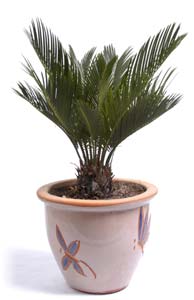Sago Palms Can Be Lethal to Cats

Sago palms (Cycas revoluta) grow naturally in tropical and sub-tropical areas. They are a common landscaping plant in these regions. The sago palm is also gaining in popularity as a houseplant because of its beauty and slow growth. Unfortunately, this plant is extraordinarily toxic to cats, dogs, and horses.
Why Are Sago Palms Poisonous to Cats?
Every part of the sago palm is incredibly toxic to cats, with the seeds or nuts being the most poisonous. The dangerous substance that the plant contains is cycasin, which causes liver failure in cats.
What Are the Signs of Sago Palm Toxicity in Cats?
Within fifteen minutes of eating any part of a sago palm, a cat may display the following gastrointestinal signs:
- Vomiting
- Diarrhea
- Drooling
- Refusal to eat
Within two to three days of ingestion of even a tiny amount of any part of a sago palm, a cat may be in acute, severe liver failure. At this time, the cat may be showing the signs of illness listed above as well as:
- Increased thirst
- Bruising
- Bloody diarrhea or black, tarry stool
- Bloody vomit
- Fluid accumulation in the abdomen (ascites)
- Yellow skin, gums, or whites of the eyes (icterus)
- Weakness
- Wobbliness
- Tremors
- Seizures
- Death
Treatment of Sago Palm Ingestion and Toxicity in Cats
There is no specific antidote for poisoning by the cycasin in a sago palm plant. The treatment for its ingestion by cats is supportive care. Depending on how much time has gone by since the cat ingested the plant, your veterinarian may do any or all of the following:
- Attempt to induce vomiting to try and remove as much of the sago palm as possible from your cat's stomach before it can be absorbed.
- Administer activated charcoal, a substance that can bind with toxins and carry them out of the system unabsorbed, if your cat isn't yet vomiting.
- Begin intravenous fluid therapy.
- Institute treatment with anti-nausea medications, anti-seizure medications, removal of fluid from the abdomen, vitamin K injections, and other treatments for liver failure.
Even with aggressive treatment, the survival rate for cats that have ingested sago palm is only around 50%.
If your cat is showing any of the above signs of illness, get to a veterinarian immediately. If you see your cat chew on or ingest any plant that you don't recognize or if you know that it is a sago palm, go to your regular veterinarian or emergency veterinarian immediately, and tell them what happened.
Sago palms are an extremely toxic plant for cats, dogs, and horses. Unfortunately, many people, including some landscapers, are not aware of this. If you have pets, make sure that you don't use sago palms inside your home or in your yard.
Spreading the word about the toxicity of sago palms for pets may help encourage sellers to label these hazardous plants before distributing them.
You May Also Like These Articles:
Common Plants Poisonous to Cats
How to Keep Your Cat from Chewing on Houseplants
Easter Lilies: A Holiday Hazard for Cats
Warning: Topical Medications Containing Flurbiprofen May Be Dangerous to Cats
Ethoxyquin, Mercury, and PCBs: Is Feeding Fish Safe for Cats?
What Does Catnip Do to Cats? Why Do Cats Like Catnip?
Notice: Ask-a-Vet is an affiliated service for those who wish to speak with a veterinary professional about their pet's specific condition. Initially, a bot will ask questions to determine the general nature of your concern. Then, you will be transferred to a human. There is a charge for the service if you choose to connect to a veterinarian. Ask-a-Vet is not manned by the staff or owners of CatHealth.com, and the advice given should not delay or replace a visit to your veterinarian.




